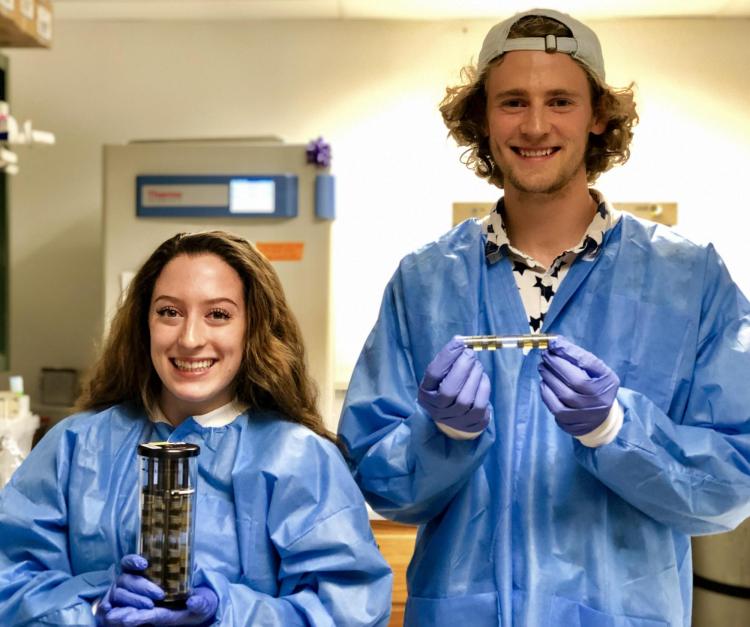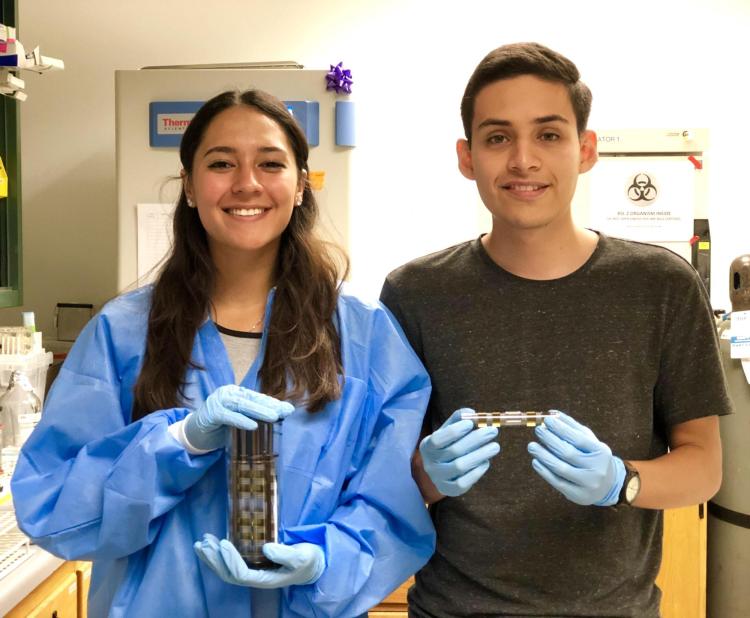Simulated Micro-, Lunar, and Martian Gravity Microbial Research
Funding Agency
NASA (80NSSC18K1468)
Project start date
October, 2018
Humans will soon explore, live, and work on the Moon and Mars. How do microbes behave when they grow at those gravities (the Moon has about one sixth of Earth's gravitational pull, while Mars has about a third)? Will we need different doses of antibiotics to fight bacterial infections depending on where (Earth, lower Earth orbit, the Moon, or Mars) they are occurring? What changes at the molecular level under each of these environments? Do the genes associated with resistance to antibiotics or the microbes' ability to cause disease change depending on the gravitational environment? Micro- (as astronauts currently experience on board the International Space Station), Lunar, and Martian gravities are simulated using a device called Clinostat, which doesn't remove the gravitational pull of Earth but allows scientists to replicate some aspects of the environment around cells at different gravitational environments.
What are the project’s objectives?
This project aims to characterize changes on cell growth dynamics and cell aggregation as a function of gravitational regime (simulated micro-, 1/6 and 1/3 g). This is complemented by gene expression analyses focused on the drug-resistance-associated genes (resistome) as well as those responsible for bacterial virulence. This systematic microbial study includes multiple commensal, opportunistic, and pathogenic bacterial and fungal strains. This study has a second component that focuses on determining if there are changes on the concentrations of drugs needed to inhibit microbial growth at different gravitational regimes.
How is this being done?
Ten different strains of bacteria (three strains of Escherichia coli, Pseudomonas aeruginosa, methicillin-resistant Staphylococcus aureus (MRSA), Salmonella, Staphilococcus epidermidis, and Shewanella oneidensis) and of fungi (Saccharomyces cerevisiae and Candida albicans) are being investigated in this project. They are cultured separately in BioServe’s Fluid Processing Apparatus (FPA), which have been operated over 5,000 times in orbit on over 40 spaceflight experiments. This helps our team compare clinostat-produce data against sets derived from actual microgravity. Reduced gravitational conditions are achieved using BioServe’s FPA Clinostats.

BioServe’s Fluid Processing Apparatus (FPA), each loaded with four independent chambers. Each chamber contains 1.3 ml of a bacterial culture.
The Team
The molecular, cellular and developmental biology (MCDB) and aerospace engineering students at BioServe Space Technologies are the backbone of this project.

Lily Allen (left) and Tadg Forward (right) holding spaceflight hardware used for this clinostat-based project: BioServe’s GAP and FPA, respectively
Lily Allen – Lily is an undergraduate student at the University of Colorado, Boulder. She is currently pursuing a B.S. in Aerospace Engineering and MCDB (double major). Lily strives to be like her idol, Doctor Strange, and would like to attend medical school to one day be a doctor. On this project, Lily has taken the lead of all laboratory work, including experiment performance, and data acquisition and analyses.
Previous students (graduated)
Tadg Forward – Tadg is a senior undergraduate student studying MCDB with a minor in Biochemistry at the University of Colorado, Boulder. Tadg is studying the effects of varying gravitational regimes for E. coli, MRSA, Candida albicans, and Salmonella typhimurium.
Visiting Scholars

Visiting scholars from Universidad del Valle de Guatemala, Katherinne Herrera (left) and Fredy España (right), holding the spaceflight hardware used on this Clinostat-based project.
Katherinne Herrera – Katherinne is working towards a B.S. in Biochemistry and Microbiology at Universidad del Valle de Guatemala and is passionate about bioastronautics. She is performing ground tests with Candida albicans to characterize changes on cell growth dynamics and phenotypic features.
Fredy España – Fredy is a Mechatronics Engineering student at Universidad del Valle de Guatemala where he leads the development of the payload of Guatemala’s first satellite, Quetzal-1. Fredy is designing a new type of Clinostat, an FPA Clinostat, during his internship at BioServe Space Technologies.
Produced Project Bibliography
Book
- Pathak, Y., Araújo dos Santos, M., Zea, L. Handbook of Space Pharmaceuticals. Springer International Publishing
Book Chapter
- Zea, L., Santa Maria, S.R, Ricco, A.J. Cubesats for Microbiology and Astrobiology Research. In Cappelleti C. and Battistini S. (Eds.), CubeSat Handbook: From Mission Design to Operation. Elsevier (pp. 147-162). Academic Press.
Journal Papers
- Santomartino, R., Zea, L. & Cockell, C.S. The smallest space miners: principles of space biomining. Extremophiles 26, 7 (2022). https://doi.org/10.1007/s00792-021-01253-w
- Gumulya, Y., Zea, L., Kaksonen, A.H., In situ resource utilisation: The potential for space biomining, Minerals Engineering, 2021; Volume 176, 107288, ISSN 0892-6875,
Conference papers, posters, podcasts, and STEM outreach
- Allen, L., Forward, T., Kalani, A., Klaus, D., Zea, L. Salmonella typhimurium, Shewanella oneidensis MR-1, and ISS-isolated Staphylococcus epidermidis: The Effect of Simulated Micro-, Lunar, and Martian Gravities on Growth and Size, and Practical Implications, IAC-22,A1,IP,x69576, 73rd International Astronautical Congress (IAC), Paris, France, 18-22 September 2022
- Zea, L., El Impacto de la Innovación, Stream your Innovation 2022, Colegios APDE, Guatemala (virtual), November 14, 2022
- Allen, L.A., Kalani, A.H., Zea, L., Ciprofloxacin Efficacy against Urinary Tract Pathogens cultured Under Simulated Micro-, Lunar, and Martian Gravities, IAC-21-A2.7.7x65129, 72nd International Astronautical Congress (IAC) 2021, Dubai, United Arab Emirates
Fiske Planetarium Podcast “A View From Earth”, Episode 8 - Life finds a Way - Or does it? Guests: Luis Zea & Bruce Jakosky, July 2020 [Podcast] [Video]
Forward, T., Allen, L., Stodieck, L., Klaus, D., Zea, L., Growth Dynamics of Bacteria Under Simulated Lunar and Martian Gravities, IAC-19-A1.8.2x51510, 70thInternational Astronautical Congress (IAC) 2019, Washington, D.C.
Links
NASA announcement: https://www.nasa.gov/feature/the-nasa-space-biology-program-selects-15-grant-proposals-for-awards

